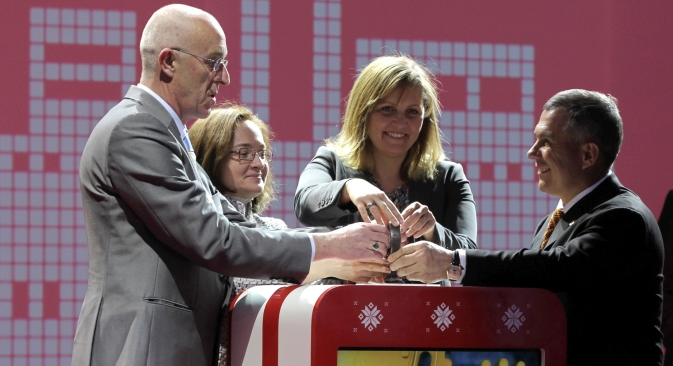
Rockwool International President Eelco van Heel, Russia's then-Economic Minister Elvira Nabiullina, Danish Trade Minister Pia Olsen Dyhr, Tatarstan's President Rustam Minnikhanov (L-R) at the Alabuga SEZ. Source: RIA Novosti / Maksim Bogodvid
The Russian government continues to struggle to improve the country's business image. At the World Economic Forum in Davos, the Russian Direct Investment Fund announced the launch of a new image campaign entitled "Invest in Russia." A major priority will be to accelerate government initiative to set up Special Economic Zones (SEZs).
The plan to polish the country's reputation will involve a number of the world's top investment banks. The first consultant is already known to be Goldman Sachs, which has been tasked with improving Russia's international image over the next three years.
Having appeared in their present form only in 2005, Russia’s SEZs now count 57 foreign companies from 21 countries among their residents. In 2012, six U.S. companies came on board. General Motors invested $180 million, 3M (industrial and household consumer goods) put in $30 million, and Armstrong (building materials) invested $75.4 million. In 2005, the U.S. invested a total of $966.4 million in SEZs.
"Our company faced a tricky choice: Where to locate our production facilities — in Russia or some other Eastern European country? In the end, we got residency status in the Alabuga SEZ in the Republic of Tatarstan last December," 3M's legal manager Alexei Zavalev told RBTH.
"Besides the benefits available, a not inconsiderable factor in our choice was the impression we gained from speaking with the SEZ managers, who represent a new breed of Russian officials with excellent English and business acumen.”
Special economic zones' companies to engage in mineral processing
Nonetheless, the tax incentives alone would have swayed the decisionmakers: 3M will pay the Russian government 2 percent for the first five years of profit-making operations, instead of the standard 20 percent.
And that is not the only privilege available in Alabuga: Given a minimum investment of €3 million ($3.8 million) to operate in the zone, the company will be granted a zero rate of VAT and import duties on equipment, which, Denmark's Rockwool, for example, has already used to save $12.6 million. Further economizing can be achieved thanks to free power, which in Moscow would cost $1 million per megawatt of capacity.
Alongside Alabuga, the management company JSC SEZ controls, with state participation, a further 16 zones — albeit with varying rates of growth. In many respects, the rate of development depends on the specifics and attitude of the local management. In seven years, SEZ has managed to raise foreign investments worth $3.6 billion.
The operating areas are divided into four types: Industrial production, tourism and recreation, ports and shipping, and technical innovation. As regards the latter, according to the Accounts Chamber of the Russian Federation, 350 patents for inventions have been filed: The list of residents includes such heavy-hitters as Boeing and Apple.
It was initially assumed that all firms would by no means be able to receive SEZ status: Investment projects had to "enrich the Russian economy with new technologies and develop the competitive and professional competencies of the Russian workforce."
Priority was to be given to projects recognized by the Russian government as nationally significant. In other words, the authorities only wanted to provide incentives to hi-tech companies. Although the example of Alabuga, one of the most successful SEZs, indicates the feasibility of accommodating a glass factory or a salad processing plant, some of whose produce is then shipped to McDonald's.
Regardless of the type of business, the process for obtaining residency status is the same for everyone.
"First of all, a set of documents is drawn up by company staff and examined by the Supervisory Board of the SEZ, after which the business project is either approved or sent back for revision," said former head of JSC SEZ, Oleg Kostin, who was replaced in early March by the head of the Kaliningrad branch of JSC SEZ, Mikhail Trushko.
"The next step is the Expert Council of the SEZ, which operates under the Russian Ministry of Economic Development," he added. "Here, the final decision is taken to adopt the project and admit the investor into the SEZ. After that, the investor concludes a tripartite agreement with the MoED and JSC SEZ on the conduct of its business inside the SEZ."
The procedure will be simplified in due course. At the very least, it dovetails nicely with the concept of improving Russia's investment climate as a matter of urgency. A presidential decree issued last May states that Russia must be in the top 20 in the Doing Business ranking by 2020 — up from its current position in 112th place. Given the dynamics of the last couple of years (up from 124th), this appears doable.
All rights reserved by Rossiyskaya Gazeta.
Subscribe
to our newsletter!
Get the week's best stories straight to your inbox